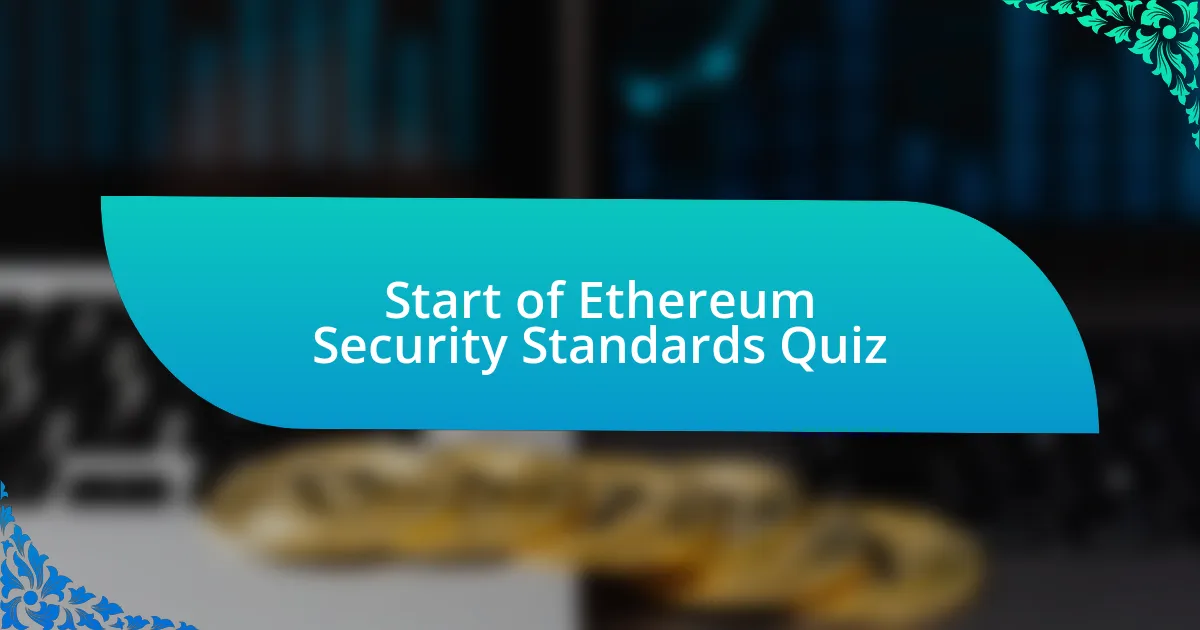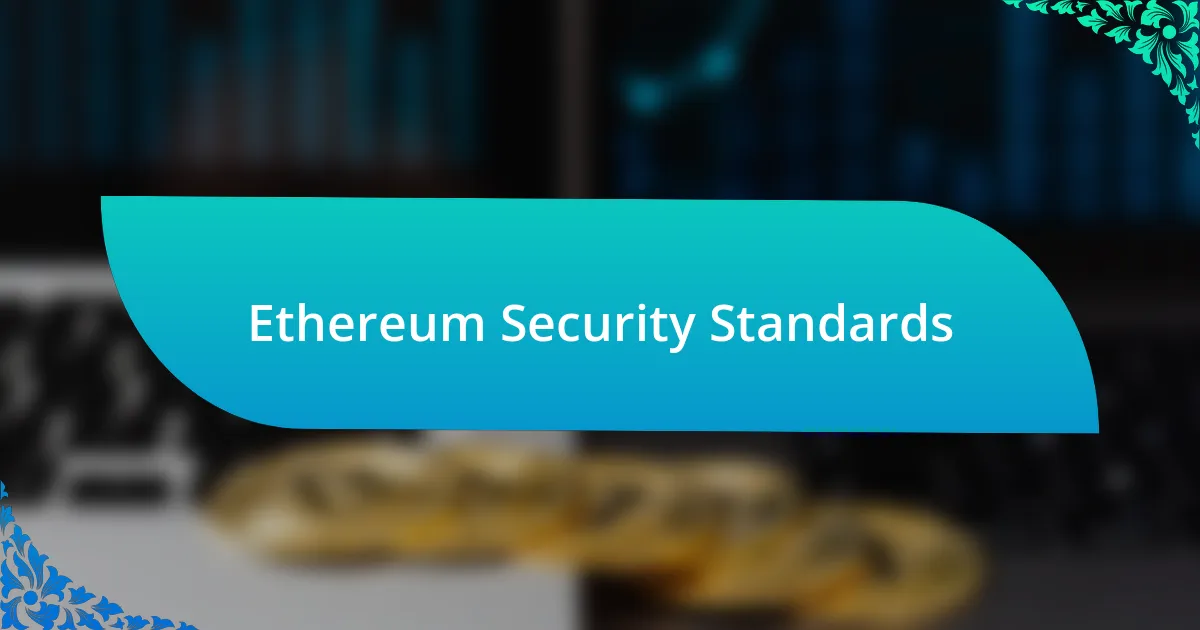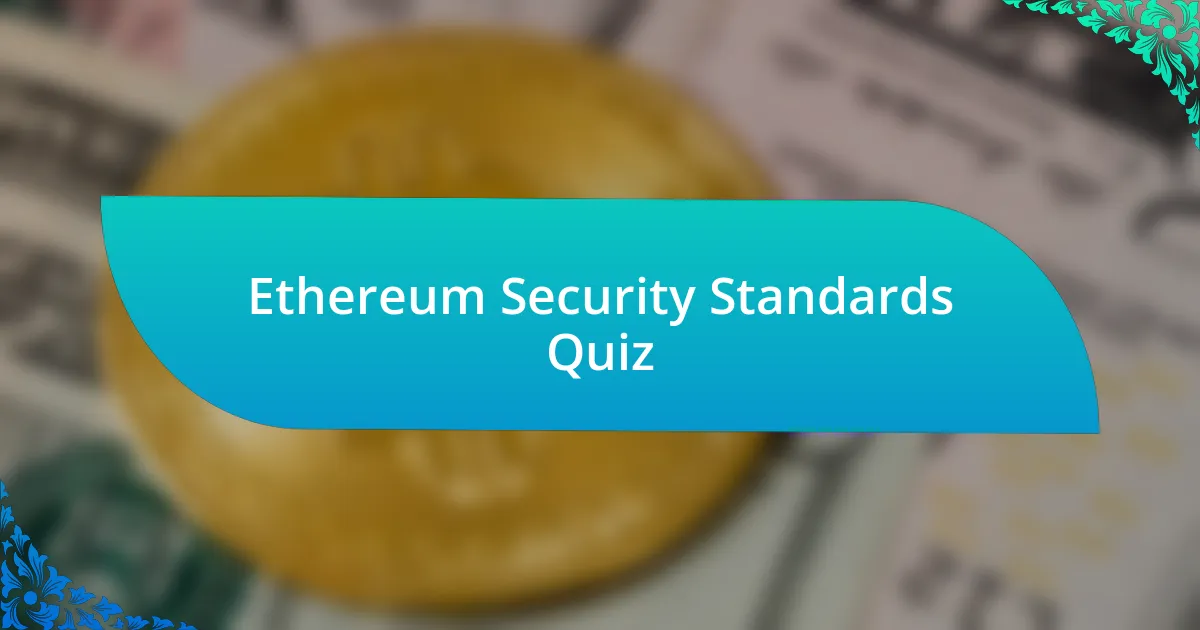
Start of Ethereum Security Standards Quiz
1. What are the primary considerations for securing smart contracts on Ethereum?
- Ensure all smart contracts are automatically updated without user consent to avoid vulnerabilities.
- Design proper access controls, use require(), assert(), and revert() statements to guard contract operations, and test smart contracts extensively.
- Write smart contracts in multiple programming languages to prevent compatibility issues.
- Optimize gas fees to ensure contract execution efficiency and improve speed.
2. What is the purpose of the require() statement in smart contracts?
- The require() statement allows functions to be called only by certain accounts.
- The require() statement is intended for logging transactions and events.
- The require() statement is used to manage contract ownership and transfer.
- The require() statement ensures predefined conditions are met before the called function is executed.
3. What types of accounts exist on Ethereum?
- Managed Accounts and Virtual Accounts
- Regular Accounts and Private Accounts
- User-Controlled Accounts and Smart Accounts
- Externally Owned Accounts (EOAs) and Contract Accounts
4. How does the Ethereum Virtual Machine (EVM) store data?
- The EVM uses big-endian ordering, where the most significant byte of a word is stored at the smallest memory address.
- The EVM uses random access storage, allowing data to be stored in any location without organization.
- The EVM stores data in a format that requires manual adjustment of byte positions by developers.
- The EVM stores data in little-endian order, placing the least significant byte first.
5. What is the smallest unit of Ether?
- shannon
- gwei
- ether
- wei
6. What is the role of assert() in smart contract security?
- Assert() ensures that invariants are enforced, triggering an asset guard if an assertion fails.
- Assert() validates user inputs before processing transactions.
- Assert() is used to provide user notifications in case of errors.
- Assert() logs all transactions to ensure transparency.
7. Why is it important to keep smart contracts simple?
- Simple contracts have fewer security measures in place.
- Complicated contracts provide higher transaction speeds.
- Complex contracts ensure better functionality and features.
- Keeping smart contracts simple reduces the potential for errors and bugs.
8. What are some best practices for Ethereum smart contracts?
- Always keep contracts complex, enhance risk exposure, and ignore usage limits.
- Be ready for failure, pause the contract if necessary, formulate an effective upgrade strategy, and manage money at risk by limiting usage rates.
- Rely solely on automatic upgrades, bypass testing, and allow unrestricted access.
- Focus only on deployment speed, ignore security measures, and avoid monitoring usage rates.
9. How can you manage risks in smart contracts?
- Rely solely on unit tests to confirm the contract`s full functionality.
- Use only private functions to ensure no external calls can be made.
- Limit the number of smart contracts deployed on the network to reduce congestion.
- Implement internal safeguards like require(), assert(), and revert() statements, and manage money at risk by limiting usage rates.
10. What is the significance of immutability in smart contracts?
- Immutability allows developers to update contract logic anytime.
- Immutability prevents all types of contract interactions altogether.
- Immutability ensures contracts can be easily modified after deployment.
- Immutability makes it difficult to recover assets from stolen contracts.
11. What are the implications of public blockchains on smart contract security?
- Smart contracts have no risks when deployed on public blockchains.
- All smart contracts are automatically secure by design.
- Public blockchains guarantee complete data privacy and security.
- Deployed contract code cannot be easily updated to fix vulnerabilities.
12. How do you ensure secure access controls in smart contracts?
- Implement access control mechanisms that restrict the ability to use certain functions in a smart contract to approved entities.
- Allow all network participants equal access to all contract functions for transparency.
- Require all contract interactions to be conducted on a centralized server for security.
- Use random user authentication for all contract functions to improve security.
13. What is the difference between public and private functions in smart contracts?
- Public functions can only be called internally, while private functions are visible to everyone.
- Public functions are limited to certain addresses, while private functions have no restrictions.
- Public functions are accessible only by the contract owner, while private functions are accessible to all.
- Public functions can be called by any externally owned accounts (EOAs) or contract accounts, while private functions can only be called by functions within the smart contract.
14. Why is unit testing insufficient for improving smart contract security?
- Unit tests cover all scenarios and ensure perfect contract behavior.
- Unit tests are sufficient by themselves for security analysis.
- Unit testing is not comprehensive and may neglect potential vulnerabilities.
- Unit testing only evaluates user inputs without testing contract logic.
15. What is the role of the Beacon Chain in Ethereum 2.0?
- The Beacon Chain is solely responsible for managing smart contracts on Ethereum.
- The Beacon Chain operates as a secondary blockchain for transaction processing.
- The Beacon Chain maintains a central authority for network governance.
- The Beacon Chain is a component of Ethereum 2.0 that helps transition from Proof of Work (PoW) to Proof of Stake (PoS).
16. What is sharding in the context of Ethereum 2.0?
- Sharding is the method for increasing mining rewards in Ethereum 2.0.
- Sharding is a scalability solution in Ethereum 2.0 that divides the network into smaller groups to improve transaction processing capacity.
- Sharding refers to the process of upgrading smart contracts automatically.
- Sharding involves merging multiple blockchains into one unified chain.
17. What are the essential terms for navigating Ethereum 2.0 security?
- Proof of Stake (PoS), Beacon Network, sharding, nodes, liquidity requirements, and consolidation
- Proof of Service (PoS), mainnet, splitting, transactors, lending requirements, and onboarding
- Proof of Work (PoW), sidechains, forks, miners, storage requirements, and merging
- Proof of Stake (PoS), Beacon Chain, sharding, validators, staking requirements, and slashing
18. What is the impact of validator misbehavior on Ethereum 2.0?
- Validator misbehavior has no consequences.
- Validator misbehavior improves network speed.
- Validator misbehavior allows for more rewards.
- Validator misbehavior leads to slashing penalties.
19. How does Ethereum 2.0 address scalability and energy consumption challenges?
- Ethereum 2.0 introduces sharding and Proof of Stake (PoS) to improve scalability and reduce energy use.
- Ethereum 2.0 addresses energy consumption by reducing transaction validation frequency across the network.
- Ethereum 2.0 uses increased block size and more nodes to enhance scalability and lower energy consumption.
- Ethereum 2.0 relies on centralized servers to solve scalability and energy issues effectively.
20. What is the significance of staking in Ethereum 2.0?
- Staking involves mining new blocks to increase block rewards in Ethereum.
- Staking is simply the process of buying and selling Ether on exchanges for profit.
- Staking allows users to trade Ether without transaction fees or penalties.
- Staking involves validators locking up Ether to participate in the network and earn rewards, with penalties for misbehavior.
21. What is the difference between Permissioned Accounts and Permissionless Accounts?
- Permissionless Accounts can only be accessed by identified users.
- Permissionless Accounts require user authentication for all operations.
- Permissioned Accounts are publicly accessible without restrictions.
- Permissioned Accounts require approval for transactions; they are more secure.
22. How can you formulate an effective upgrade strategy for smart contracts?
- Create a complex contract structure that makes changes easy and quick without safeguards.
- Rely solely on community feedback without implementing any structured approach to upgrades.
- Ignore potential bugs and upgrades to save time and resources during the development process.
- Formulate an upgrade strategy with improvements and methods to fix bugs, loopholes, etc., and manage the money at risk by limiting usage rates.
23. What is the purpose of the assert() statement in token issuance contracts?
- The assert() statement is used for logging events in the contract execution.
- The assert() statement ensures that invariants are enforced, such as the token to Ether issuance ratio, triggering an asset guard if an assertion fails.
- The assert() statement sets the maximum supply of tokens in the contract.
- The assert() statement prevents unauthorized access to the smart contract functions.
24. What are some general best practices for Ethereum smart contracts?
- Ensure all functions are public, and do not allow pauses or upgrades for contract integrity.
- Avoid extensive testing and audits to save resources and keep the contract lightweight.
- Use complex logic and tight coupling between contracts to enhance security and functionality.
- Be ready for failure, pause the contract if necessary, formulate an effective upgrade strategy, and manage money at risk by limiting usage rates.
25. How can you ensure that your smart contract functions as expected?
- Write small unit tests using mock data that the contract is expected to receive from users.
- Use complex code structures to enhance functionality and ensure performance.
- Conduct large-scale audits from third-party firms before deployment.
- Deploy the contract without any testing as a measure of confidence.
26. What is the significance of immutability in Ethereum?
- It ensures the robustness of smart contracts and the blockchain network.
- It simplifies the process of executing smart contracts.
- It enables unlimited asset recovery for stolen funds.
- It allows for changes to the contract code after deployment.
27. What is the role of validators in Ethereum 2.0?
- Validators create new blocks and validate transactions automatically, no penalties apply.
- Validators lock up Ether to participate in the network and earn rewards, with penalties for misbehavior.
- Validators primarily enforce gas fees and manage cryptocurrency exchanges.
- Validators only monitor network traffic without influencing transaction processing conditions.
28. How can you implement internal safeguards in smart contracts?
- Rely on community-driven content moderation and reviews.
- Set a maximum gas limit for all contract interactions.
- Use external audits and user feedback forms for security.
- Implement internal safeguards like require(), assert(), and revert() statements.
29. What challenges does Ethereum face in maintaining network security?
- Validator misbehavior can result in slashing penalties.
- Network security depends exclusively on external audits.
- Ethereum relies solely on Proof of Work for security.
- Smart contracts do not require any testing for security.
30. Why is conducting a comprehensive security audit necessary for Ethereum contracts?
- To ensure higher token distribution rates
- To enhance user interface design
- To identify and fix vulnerabilities in the contracts
- To increase transaction speed on the network

Quiz Completed Successfully!
Congratulations on completing the quiz on Ethereum Security Standards! We hope you enjoyed the experience and gained valuable insights along the way. Understanding security standards is crucial in the evolving landscape of Ethereum and blockchain technology. You’ve tested your knowledge and perhaps even uncovered new concepts that will aid in your journey through this complex subject.
Throughout this quiz, you’ve learned about various security protocols, risks, and practices that are essential for maintaining the integrity of Ethereum. This understanding not only enhances your comprehension of cryptocurrency but also equips you with the tools to better navigate this dynamic environment. Knowing what to look for in security standards can significantly impact how you interact with Ethereum and its ecosystem.
We encourage you to explore the next section on this page, which dives deeper into Ethereum Security Standards. There, you will find detailed information and resources that will further enhance your understanding. Keep expanding your knowledge and stay informed as this field continues to grow and evolve!

Ethereum Security Standards
Overview of Ethereum Security Standards
Ethereum security standards are guidelines and best practices designed to safeguard the Ethereum blockchain and its applications. They focus on protecting user assets, ensuring data integrity, and maintaining network reliability. These standards encompass various aspects, including smart contract security, decentralized finance (DeFi) protocols, and user authentication. Adherence to these standards helps mitigate risks related to hacks, fraud, and system failures.
Smart Contract Security Measures
Smart contracts are self-executing contracts with the terms of the agreement directly written into code. Security measures for smart contracts include code audits, formal verification, and best coding practices. Regular audits identify vulnerabilities, while formal verification mathematically proves the correctness of code. Following established patterns, like those defined in the Solidity guidelines, further minimizes risks related to logical errors and exploits.
Decentralization and Its Role in Security
Decentralization is a core principle of Ethereum that enhances security by distributing control across a network of nodes. This structure prevents a single point of failure and protects against censorship and unauthorized access. The Proof of Stake consensus mechanism also contributes to security, as it reduces the likelihood of double-spending and ensures that malicious actors must hold a substantial stake to compromise the network.
Ethereum Improvement Proposals (EIPs) and Security Enhancements
Ethereum Improvement Proposals (EIPs) are formal designs for enhancing the Ethereum network, including security-focused proposals. EIPs 1559 and 3074, for example, improve transaction handling and reduce potential attack surfaces. Each EIP undergoes community discussion and review before implementation, ensuring that only vetted changes are adopted to enhance the overall security of the ecosystem.
Regulatory Compliance in Ethereum Security
Regulatory compliance involves adhering to laws and regulations relevant to the Ethereum network, impacting its security standards. Compliance with regulations, such as the General Data Protection Regulation (GDPR), ensures user data protection and increases trust in the platform. Implementing Know Your Customer (KYC) and Anti-Money Laundering (AML) measures also strengthens security by reducing the risk of fraudulent activities on the network.
What are Ethereum Security Standards?
Ethereum security standards refer to a set of protocols and best practices designed to protect the Ethereum blockchain and its applications from vulnerabilities and attacks. These standards include guidelines for smart contract security, secure development practices, and regular audits. The adoption of established standards, such as the Ethereum Improvement Proposals (EIPs) related to security, helps mitigate risks and enhances the overall integrity of the Ethereum ecosystem.
How are Ethereum Security Standards implemented?
Ethereum security standards are implemented through a combination of development best practices, code audits, and security tools. Developers follow secure coding guidelines and utilize tools such as static analyzers and fuzzers to identify vulnerabilities in smart contracts. Additionally, third-party security audits are conducted to evaluate the security posture of decentralized applications (dApps) before they launch on the Ethereum network.
Where can developers find Ethereum Security Standards?
Developers can find Ethereum security standards documented in various resources, including the Ethereum Foundation’s website and GitHub repositories. The OpenZeppelin library offers a comprehensive set of security guidelines and best practices for smart contracts. Furthermore, the Ethereum Community Forum discusses new proposals and security concerns, providing a platform for collaboration and knowledge sharing.
When were Ethereum Security Standards established?
Ethereum security standards began to take shape following the 2016 DAO hack, which highlighted significant vulnerabilities within smart contracts. Since then, the development community has worked to establish formal security guidelines and practices. The continuous evolution of standards occurs with each major update to the Ethereum protocol, reflecting the lessons learned from past security incidents.
Who is responsible for Ethereum Security Standards?
The responsibility for Ethereum security standards is shared among the Ethereum community, developers, auditors, and organizations like the Ethereum Foundation. Collaborative efforts from independent security firms also contribute to the enhancement of these standards. Additionally, the broader blockchain community actively engages in discussions and provides feedback to continuously improve security protocols and practices.

